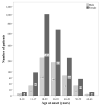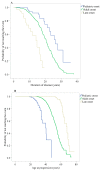Clinical Characteristics and Disability Progression of Early- and Late-Onset Multiple Sclerosis Compared to Adult-Onset Multiple Sclerosis
- PMID: 32370288
- PMCID: PMC7290335
- DOI: 10.3390/jcm9051326
Clinical Characteristics and Disability Progression of Early- and Late-Onset Multiple Sclerosis Compared to Adult-Onset Multiple Sclerosis
Abstract
Background: Compared to the adult onset of multiple sclerosis (AOMS), both early-onset (EOMS) and late-onset (LOMS) are much less frequent, but are often under- or misdiagnosed. The aims of the present study were: 1. To compare demographic and clinical features of individuals with EOMS, AOMS and LOMS, and 2. To identify predictors for disability progression from relapsing remitting MS (RRMS) to secondary progressive MS (SPMS).
Method: Data were taken from the Isfahan Hakim MS database. Cases were classified as EOMS (MS onset 18 years), LOMS (MS onset >50 years) and AOMS (MS >18 and 50 years). Patients' demographic and clinical (initial symptoms; course of disease; disease patterns from MRI; disease progress) information were gathered and assessed. Kaplan-Meier and Cox proportional hazard regressions were conducted to determine differences between the three groups in the time lapse in conversion from relapsing remitting MS to secondary progressive MS.
Results: A total of 2627 MS cases were assessed; of these 127 were EOMS, 84 LOMS and 2416 AOMS. The mean age of those with EOMS was 14.5 years; key symptoms were visual impairments, brain stem dysfunction, sensory disturbances and motor dysfunctions. On average, 24.6 years after disease onset, 14.2% with relapsing remitting MS (RRMS) were diagnosed with secondary progressive MS (SPMS). The key predictor variable was a higher Expanded Disability Status Scale (EDSS) score at disease onset. Compared to individuals with AOMS and LOMS, those with EOMS more often had one or two relapses in the first two years, and more often gadolinium-enhancing brain lesions. For individuals with AOMS, mean age was 29.4 years; key symptoms were sensory disturbances, motor dysfunctions and visual impairments. On average, 20.5 years after disease onset, 15.6% with RRMS progressed to SPMS. The key predictors at disease onset were: a higher EDSS score, younger age, a shorter inter-attack interval and spinal lesions. Compared to individuals with EOMS and LOMS, individuals with AOMS more often had either no or three and more relapses in the first two years. For individuals with LOMS, mean age was 53.8 years; key symptoms were motor dysfunctions, sensory disturbances and visual impairments. On average, 14 years after disease onset, 25.3% with RRMS switched to an SPMS. The key predictors at disease onset were: occurrence of spinal lesions and spinal gadolinium-enhancement. Compared to individuals with EOMS and AOMS, individuals with LOMS more often had no relapses in the first two years, and higher EDSS scores at disease onset and at follow-up.
Conclusion: Among a large sample of MS sufferers, cases with early onset and late onset are observable. Individuals with early, adult and late onset MS each display distinct features which should be taken in consideration in their treatment.
Keywords: EDSS score; age of onset; early onset; late onset; magnetic resonance imaging; multiple sclerosis; predictors; relapsing-remitting MS; secondary progressive MS.
Conflict of interest statement
The authors declare no conflicts of interest.
Figures





References
-
- McDonald W.I., Compston A., Edan G., Goodkin D., Hartung H.P., Lublin F.D., McFarland H.F., Paty D.W., Polman C.H., Reingold S.C. Recommended diagnostic criteria for multiple sclerosis: Guidelines from the International Panel on the diagnosis of multiple sclerosis. Ann. Neurol. Off. J. Am. Neurol. Assoc. Child. Neurol. Soc. 2001;50:121–127. doi: 10.1002/ana.1032. - DOI - PubMed
-
- Polman C.H., Reingold S.C., Edan G., Filippi M., Hartung H.P., Kappos L., Lublin F.D., Metz L.M., McFarland H.F., O’Connor P.W. Diagnostic criteria for multiple sclerosis: 2005 revisions to the “McDonald Criteria”. Ann. Neurol. Off. J. Am. Neurol. Assoc. Child. Neurol. Soc. 2005;58:840–846. doi: 10.1002/ana.20703. - DOI - PubMed
LinkOut - more resources
Full Text Sources

